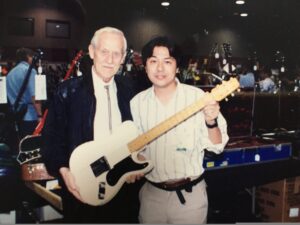I first met him at the G&L factory in the 1980s during an interview with Leo Fender. Subsequently, when I wrote an article about the G&L factory, I had the opportunity to see him again.
Around that time, I began visiting him frequently to learn about the history of Fender’s early days. Despite the passing decades, his memory remained sharp. Our conversations and interviews took place at his house or at Polly’s on Raymond Ave, which was only a few minutes away from the original Fender factory location.
He was kind and patient, generously sharing stories about how the company grew and providing insights into the construction of guitars during that era.
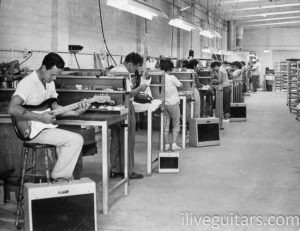
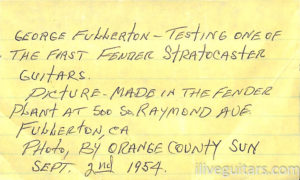
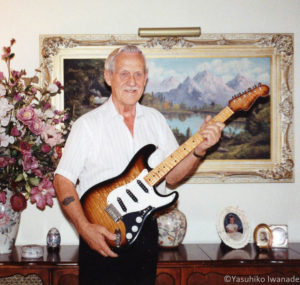

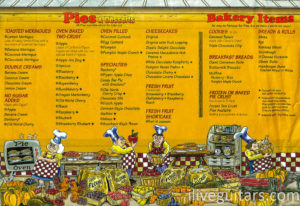

During one of meetings at his home he showed me an unfinished Strat neck. It was not even sanded so it still showed cutter marks. It was a 54 neck.
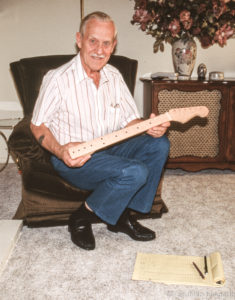
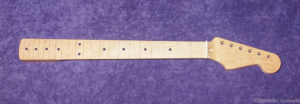
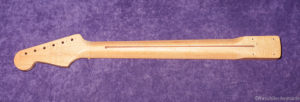
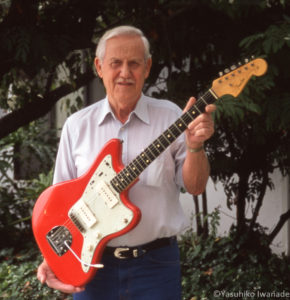
From THE GALAXY OF STRATS book
Interviewer: Yasuhiko Iwanade
George Fullerton
“I take great pride in the fact that what we created continues to be the best even today.”
George Fullerton, who supported Leo Fender’s achievements as his right-hand man since the late 1940s. His responsibilities ranged from design work and prototype production to setting up and managing production lines, and sometimes even fabricating the machining equipment itself, covering all aspects of production. Here, let’s hear from him as a participant about the circumstances leading up to the birth of the Stratocaster and the subsequent evolution.
Q: First, I would like to ask about the period leading up to the birth of the Stratocaster. As the third solid-body guitar following the Broadcaster/Telecaster and Precision Bass, what was the background behind the development of the Stratocaster?
A: The Telecaster was very well received by players, and we were also strongly committed to it, but we received various feedback based on that foundation. The feedback was of high quality, and we concluded that it would be better to create a new model rather than make minor changes to the Telecaster. It also matched the sales department’s need to expand the lineup.
Q: In terms of meeting the demands of users at the time, what specifications did you incorporate first?
A: The vibrato system. At that time, the Paul Bigsby unit was starting to circulate and received excellent reviews, so we immediately thought about incorporating something that would surpass it into the guitar.
Q: What about other specifications, such as the innovative body styling?
A: This was a further development of the concept we cultivated during the development of the Precision Bass. In the Precision Bass, we extended the horn on the 4-string side, improving the holding balance and achieving weight reduction. We applied that to the Stratocaster.
Q: Having three pickups was also unique at the time.
A: The Telecaster had boom pickups in the front and treble-strong pickups in the rear, but there was a desire for a middle sound that would bridge the contrast between them.
Q: The control system supporting the three-pickup system is also very innovative.
A: While ensuring the necessary functions, I made an effort to keep the controls as simple as possible. I carefully considered the placement, and I positioned the volume control in a location where you could change the volume while playing, enabling what is commonly known as the violin technique. I also designed completely new knobs specifically for the Stratocaster. Moreover, the method of incorporating everything on top of the pickguard was an entirely new approach for this type of guitar.
Q: What was the background behind the shape of the headstock?
A: It was a result of our efforts to create something more complex than the Telecaster design.
Q: Returning to the topic of the tremolo, it is said that the version that was supposed to debut in 1953 had a completely different design. What were the circumstances around that?
A: In 1953, all the tooling (note: the process of creating molds for the main body and parts for full-scale production) for the Stratocaster was completed, and the bodies were already flowing through the production line, with more than 100 bodies being painted. However, during the final stage of testing, we discovered a flaw in the design of the tremolo section.
Q: Then how was the second version that we currently see born?
A: To make the Stratocaster a reality, we continued to develop it without giving up. However, we reached a deadlock as no solution was found, and the staff’s anguish deepened.
Then, one day, Leo finally found a solution. “The bridge should be made heavier!” Leo said, placing an iron block on top of the bridge. At that moment, the sustain that had been lost returned.
Leo’s discovery was a delightful surprise for us, but there was another good thing. The iron block gave the Stratocaster a unique tone. The pure and clear tone was exactly what we aimed for in an electric guitar. I believe that day was the day the Stratocaster was born.
Q: It’s also groundbreaking that all strings can achieve octave with the 6-way saddle, right?
A: This was strongly requested by Bill Carson.
Q: Now let’s talk about what happened after the birth of the Stratocaster. In what month of 1954 did production begin?
A: I think we started making them in March or April. We had to meet the deadline for the NAMM Show, which took place at the end of June and the beginning of July every year. So, I think the full-scale production started in September.
Q: How was the market’s response?
A: The reaction from users and dealers was very positive, and the Stratocaster quickly penetrated the market like wildfire.
Q: In the Telecaster, the body was made of ash, and initially, the Stratocaster was also made of ash. However, in 1956, the Stratocaster was switched to alder. What was the reason for that?
A: As the recognition and acceptance of our guitars increased, the production numbers also rose. However, the lightweight ash that we wanted was in short supply and not stable. So, we needed to find another material, and that’s when alder was chosen. Alder was lightweight, had good workability, good paint adhesion, and ideal qualities for a solid-body guitar. And above all, we liked the sound that came from Alder bodies.
Q: Compared to the light-colored ash, alder has a plain color when left unpainted. It seems that bleaching was done at that time for that reason.
A: That’s right. Indeed, alder had such issues when it came to achieving a sunburst finish. Sunburst effects occur when light reflected from the material passes through the color layers. With a darker color, there is less light reflection, and it doesn’t create a beautiful sunburst effect. Bleaching was done to solve this problem.
Q: In 1958, sunburst added red and became a 3-tone finish. What was the reason for that?
A: I think it was probably a request from Fender Sales.
Q: In the following year, 1959, there was a major specification change with the introduction of rosewood fingerboards.
A: I think there were practical reasons and user requests for this change. With Fender’s maple neck, the surface finish would wear off as you played, exposing the maple and causing dirt to accumulate on the fingerboard. Such issues were raised as complaints, and the introduction of rosewood fingerboards was decided as a solution. However, Leo always said that a one-piece maple neck was superior and opposed the change until the end.
Q: When I heard you speak before, you mentioned that when different materials are glued together, it becomes like a bimetal, making it more susceptible to warping due to environmental factors, especially temperature changes.
A: That’s correct. That’s why we switched from flat bonding surfaces to curved ones. The bonding surface matches the radius of the finger.
Q: In the following year, 1959, there was a significant specification change with the introduction of the rosewood fingerboard, right?
A: Yes, I believe that change was driven by practical considerations and user demand. With Fender’s maple neck, over time, the surface finish would wear off from playing, exposing the maple and causing dirt to accumulate on the fingerboard. These issues were raised as complaints, and the solution was to introduce rosewood fingerboards. However, Leo (Fender) remained opposed to this change, stating that the maple one-piece neck was superior until the end.
Q: When I spoke with you previously, you mentioned that using different materials together would create a sort of bimetallic effect, making the neck more prone to warping due to environmental factors, especially temperature changes.
A: That’s correct. That’s why we quickly switched from flat mating surfaces to curved ones. The mating surface matches the radius of the fingerboard, and the fingerboard itself is only applied to the surface of the neck. This minimizes the impact on the entire neck due to changes in the fingerboard material.
Q: It seems you always listened to the market’s voice and made efforts to meet user needs.
A: Yes, I take great pride in the guitars we were able to create through such continuous efforts. We poured all our energy into making guitars like the Telecaster, Precision Bass, and Stratocaster. I truly feel a great sense of pride that what we created at that time continues to be the best. I also feel fortunate to have been present and to have played a part in history.
Yasuhiko: Thank you for your valuable time.
